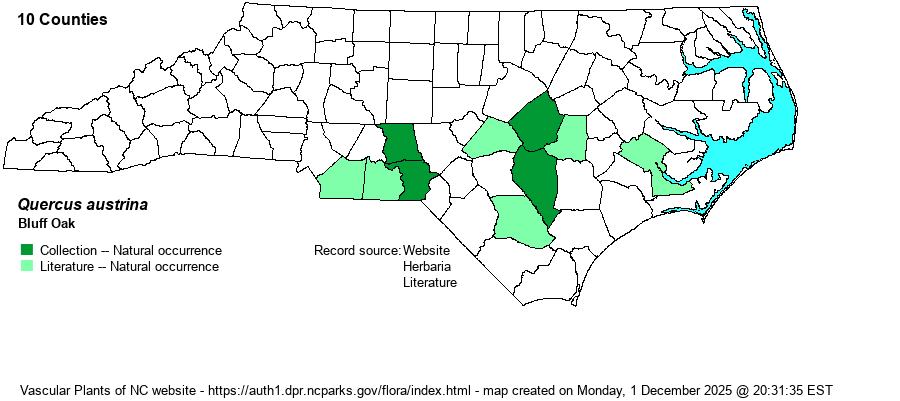| Author | Small | |
| Distribution | Widely scattered over the central and southern Coastal Plain, and the southern Piedmont, north to Johnston County. Reports from Bladen, Harnett, Union, and Wayne counties are all from USDA website and lack specimen vouchers at SERNEC. NCNHP reports a record from Craven County.
Scarce across its small range, occurring north to central NC, northern AL, and southern AR, and south into central FL. Known to occur in only seven states -– AR, MS, AL, GA, FL, SC, and NC.
| |
| Abundance | Despite records for 9-10 counties (if correctly identified), it is very rare in NC, and quite restricted in habitat. Where found, only a very few individuals are generally seen. In addition, due to its similar appearance to White Oak (Quercus alba), it can be easily overlooked. It is State Significantly Rare. | |
| Habitat | This species is essentially found only on higher pH soils, mainly on bluffs and slopes, and along riverbanks/levees. There are a few reports from bottomlands and drier swamps, presumably where the soil is somewhat circumneutral. |
| Phenology | Flowers in April, and fruits (acorns) in October of the same season. | |
| Identification | This is a very poorly known (in NC) deciduous tree, typically a tall tree up to 100 feet or taller. It is easily confused with White Oak. However, Bluff Oak normally has fewer and shorter lobes -– often only 5 lobes; and with the shortness of the lobes, the leaf is narrower than White Oak leaves. Normally one must looks at a number of leaves on a given tree to be sure you have this rare species; simply looking at one or two leaves is typically not enough to be certain. There are slight differences in the acorn from that of White Oak; see references for this distinction. | |
| Taxonomic Comments | There has been some confusion of this species with the Bastard Oak (Q. sinuata), which is synonymous with Q. durandii. Q. sinuata occurs north only to northern SC, and thus could occur in adjacent NC. Q. austrina has also been known as “Bastard Oak”, or “Bastard White Oak”, as has been Q. sinuata/durandii, thus adding to the confusion.
| |
| Other Common Name(s) | Bastard Oak, Bastard White Oak | |
| State Rank | S1 | |
| Global Rank | G4? | |
| State Status | SR-P | |
| US Status | | |
| USACE-agcp | | |
| USACE-emp | | |

